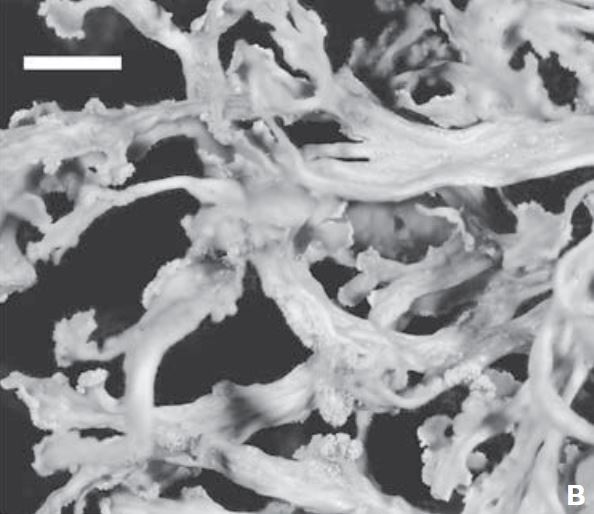Ramalina carminae R. Arroyo & Seriñá
in Arroyo & al., Bot. Complut., 35: 6, 2011.
Synonyms:
Distribution: C - Sar (Arroyo & al. 2011).
Description: Thallus fruticose, shrubby, erect to subpendulous, yellowish green, matt, of 1-6 cm long, 0.5-1.25 mm wide, richly and irregularly branched, often twisted, irregularly grooved laciniae, with veins projecting especially in the lower surface and sorediate cracks on the upper surface, especially at tips. Soralia scattered, tending to the labriform type or developed under the thin, finger-shaped apical branches, more rarely capitate or helmet-shaped; soredia granular, 50-80 μm in diam. Pseudocyphellae sparse, oval. Cortex 2-layered, the outer part paraplectenchymatous, 7-12 µm thick, the inner part consisting of a more or less continuous, uneven, 60-250 μm thick chondroid layer, sometimes filling the entire inner part of the laciniae; medulla white, lax. Photobiont chlorococcoid. Spot tests: cortex K-, C+ and KC+ weakly yellow, P-, UV-; medulla and soralia K+ weakly yellow, KC+ orange, P-, UV-. Chemistry: cortex with usnic acid; medulla with variolaric acid.Note: a recently-described species in the R. polymorpha-complex, hitherto known from the Iberian Peninsula and Sardinia, characterised by the presence of soredia and of variolaric acid.
Growth form: Fruticose
Substrata: rocks
Photobiont: green algae other than Trentepohlia
Reproductive strategy: mainly asexual, by soredia, or soredia-like structures (e.g. blastidia)
Commonnes-rarity: (info)
Alpine belt: absent
Subalpine belt: absent
Oromediterranean belt: absent
Montane belt: absent
Submediterranean belt: absent
Padanian area: absent
Humid submediterranean belt: absent
Humid mediterranean belt: very rare
Dry mediterranean belt: extremely rare

Predictive model
Growth form: Fruticose
Substrata: rocks
Photobiont: green algae other than Trentepohlia
Reproductive strategy: mainly asexual, by soredia, or soredia-like structures (e.g. blastidia)
Commonnes-rarity: (info)
Alpine belt: absent
Subalpine belt: absent
Oromediterranean belt: absent
Montane belt: absent
Submediterranean belt: absent
Padanian area: absent
Humid submediterranean belt: absent
Humid mediterranean belt: very rare
Dry mediterranean belt: extremely rare

Predictive model
 Index Fungorum
Index Fungorum
 GBIF
GBIF


